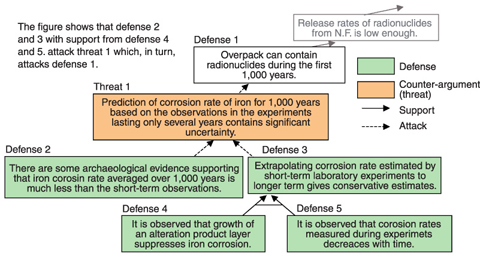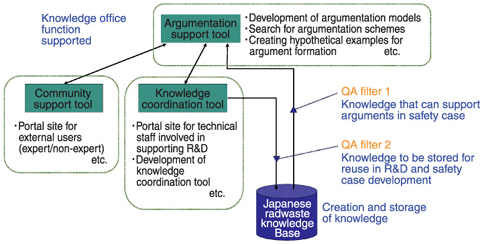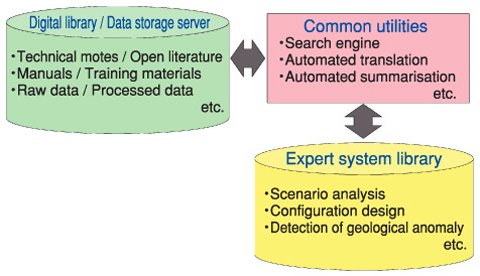Fig.2-3 Fundamental concept of JAEA KMS

Fig. 2-4 An example of argumentation model

Fig.2-5 An illustration of the present concept for linkage of toolkits to provide an "intelligent assistant"

Fig.2-6 Outline of the present conception of the KB in the JAEA KMS
The implementation process for the geological disposal of high-level waste (HLW) utilizes vast quantities of information, data, experience, understanding, etc. _which can be defined broadly as "knowledge". In order to improve confidence in the safety of geological disposal, it is necessary to collate, integrate and quality assure appropriate knowledge, extending it where needed with focused studies and taking particular account of advances in diverse areas of science and technology that are of relevance here. We, therefore, have initiated a project to develop a "next generation" knowledge management system (KMS), which will incorporate an "intelligent assistant" , utilizing advanced electronic information management technology.
Based on the fundamental KMS concept (Fig.2-3), preliminary design of the required management functions and Knowledge Base (KB) has been carried out. In this design, a framework of knowledge management that optimizes production, dissemination, and use of the relevant knowledge is proposed, based on a concept that regards construction of the safety case as chains of arguments and counter-arguments (argumentation model, Fig.2-4).
In addition to this argumentation support tool, a knowledge coordination tool for experts and community-ware for interested non-experts have been specified as required system components. Fig.2-5 illustrates the present concept of subcomponent the "intelligent assistant" . In this concept, an " argumentation support tool" aids development of argumentation models, searching for alternative argumentation schemes, and creating hypothetical examples for argumentation. This tool mainly supports the knowledge office. The "knowledge coordination tool" , on the other hand, provides a portal site for technical staff involved in supporting R&D, providing access to the KB and tools that help them put their work in the context of appropriate safety case components and argumentation schemes. The " community support tool" provides a portal site specifically for external users, tailored to facilitate use by both expert and non-expert stakeholders.
The present concept for the KB is illustrated in Fig.2-6, although again this is currently under development and hence should be regarded as a provisional conceptual outline only. The present concept envisages a "digital library/data storage server" , an "expert system library" and an additional group of "common utilities" . In any case, as emphasized above, the key aspect of the KB is its flexibility to provide output structured to any desired application. A priority, therefore, is the implementation of user-friendly search engines, which allow such tailoring of output.
Taking account of both present requirements and possible future needs of users, we will develop a prototype of a novel KMS within the current 5-year R&D program (up to fiscal year 2010).
<Previous: 2 Research and Development on Geological Disposal of High-Level Radioactive Waste | Next: 2-2 >